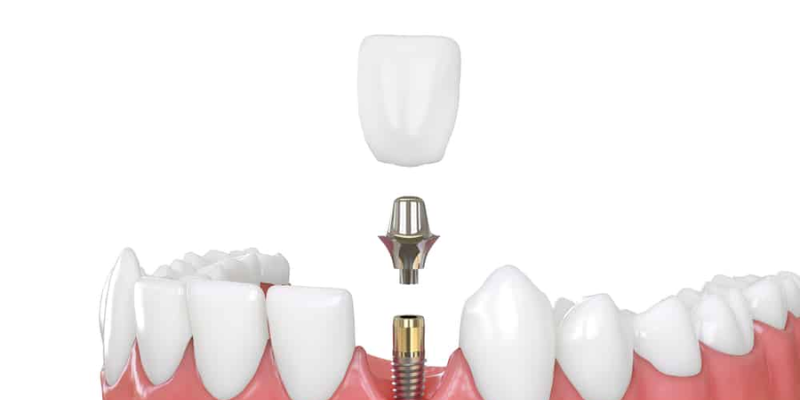Dental Implant Process
Dental implant process is a frequently asked dental procedure. Modern medicine benefits greatly from the rapid advancement of technological capabilities. In recent years, dentistry has also taken a bite out of this. Teeth that are missing are both a health and an aesthetic concern. Dentistry has benefitted from technological advancements as well. The conventional bridge and prosthesis has been replaced by the implant dental therapy.
What is an implant, how is it placed, and to whom is it administered? Implants are titanium screws that are inserted into the jawbone to replace lost teeth. These screws support a dental prosthesis. Implant therapy has a distinct benefit over other treatments in that it does not harm surrounding teeth. That is, there is no need to trim neighboring teeth. You can eat, speak, and laugh just as you would with a normal tooth. Thanks to the implant’s role as a root.
An implant procedure may only be used on people who are at least 18 years old and have finished the growth of their jaw and face. X-rays are taken before the procedure to see whether the jaw structure is appropriate for the implant. Before treating diabetics, the illness must be under control. Preparation for therapy begins with the discontinuation of blood thinners in individuals who are using them. Implant therapy is available to those with osteoporosis who have received suitable treatment. Implant therapy is done by giving the patient a mild sedation. Before the operation, a thorough checkup and x-ray are necessary. Remaining teeth and bone measurements are collected. Dental implants may be inserted in one of two ways: surgically or anesthetically. After the implant has been put, a temporary cap is added as part of the one-step surgery.
Dental Implant Process Effectively
After the dental implant is inserted, it is covered by the gum. Let to recover for a period of time. Prosthetic heads are then connected. There is a three-month healing time for the lower jaw and a six-month healing period for the upper jaw in both situations. In certain cases, new teeth may be attached to dental implants shortly after they’ve been created. Dental implants allow patients to eat and laugh without fear. Implants made of zirconium are the latest generation, designed to be more resistant to wear than titanium ones. Strengthening the jawbone is a common usage of this supplement. The only difference between it and titanium is that it is more durable. Dentists employ zirconium veneers as well. In terms of brightness, zirconium is comparable to the color of real teeth. Because of this, it serves a dual purpose in terms of both beauty and durability.
No rust or metallic taste is left on the tongue. Over time, the color does not alter. The body is not harmed in any way. Braces are made up of two parts. A bracket that is affixed to the teeth, and a wire that connects them. Intermittent teeth, crooked teeth, bite problems, damaged teeth, and overlapping teeth may all be corrected with braces. Braces may be worn at any time in a person’s life. Treatment with braces typically lasts between 18 and 24 months. This therapy may last up to three years in the most severe cases. Aside from highly sticky foods, patients with braces may eat and drink anything. They must, however, exercise extreme caution when it comes to hygiene. To put it another way, gingival recession occurs when the gingiva recedes beyond the enamel layer. Such that the tooth root may be seen.
What Is Dental Implant Process?
Causes include hereditary susceptibility, poor coatings, frequent brushing, and calculus. In addition to bad breath and bleeding while brushing, receding gums may cause edema and gum redness. Tooth loss is another possibility if your gums begin to recede. Different filling methods are used to address the gingival recession. A whole tooth may be protected in this manner. Surgeons may be called on to do surgery in more severe circumstances. Surgeons use either a graft from the palate or healthy tissue from the surroundings. To cover the retracted region in the surgical approach. The retracted area is then covered with the graft. Dental implants are titanium-based materials that serve as prosthetic tooth roots. These materials are inserted into the bone if the amount of bone in the missing tooth cavities is adequate.
A certain amount of time is needed before prosthetics may be built to cover the top structures. After the implant has been inserted into the bone. During the procedure in which a tooth is removed, implants may be inserted immediately. Immediate implant application is the name given to this procedure. If there is no inflammatory condition on the same day as the loss of the tooth for whatever cause. Then immediate implants may be used to replace it. Immediate loading refers to the procedure in which the prosthesis. It is coating are put simultaneously to the immediate implant inserted following extraction. Aesthetic aspects of the smile are often targeted by these treatments. Even if the individual isn’t bothered by the gap left by missing teeth, it’s important to get them filled in as soon as feasible.
Is The Treatment Permanent?
The nearby teeth will tilt over towards the open gaps if the gaps aren’t filled. It will cause the closing relationships to break down. As time passes, the bone in the area of the jaw where there is no tooth will begin to deteriorate. These gaps can only be filled with a bridge procedure if both of the surrounding healthy teeth are also removed. It is resulting in the jawbone melting even more. Implants that mimic the function of dental roots are the best therapy for these disorders. Prior to the procedure, the patient should be in excellent general condition. With normal levels of blood coagulation and wound healing.
Because the implants are attached to the jawbone. There has to be enough bone density in the region where they will be placed. To provide the most accurate measurements of bone density and thickness, three-dimensional imaging (tomography) is often used. Bone powder from animal bones may be used to thicken the jawbone. Prepare it for implant implantation if there is inadequate natural bone tissue
What is Included in Hair Implant Istanbul Cost?
The hair implant Istanbul cost varies from clinic to clinic, and even the type of hair transplant procedure chosen by the patient can have an impact on the total cost. It is important for patients researching the best hair implant In Turkey in Istanbul to consider any additional costs that may be incurred such as pre-operative tests, medications and post-operative appointments. Additionally, travel costs should also be taken into consideration if the patient is coming from out of town.

The best way to get a better understanding of what is included in the hair implant Istanbul cost is by consulting with a qualified hair transplant specialist at a nearby clinic. They can provide accurate information on what services are included in their pricing structure and discuss any potential add-on services or extra fees. A consultation can also help individuals decide which type of treatment best suits their individual needs and budget. Taking the time to read reviews from and experiences of other patients and determine which doctor has the most experience with hair implants in Istanbul can also make a big difference in how successful your treatment turns out.



